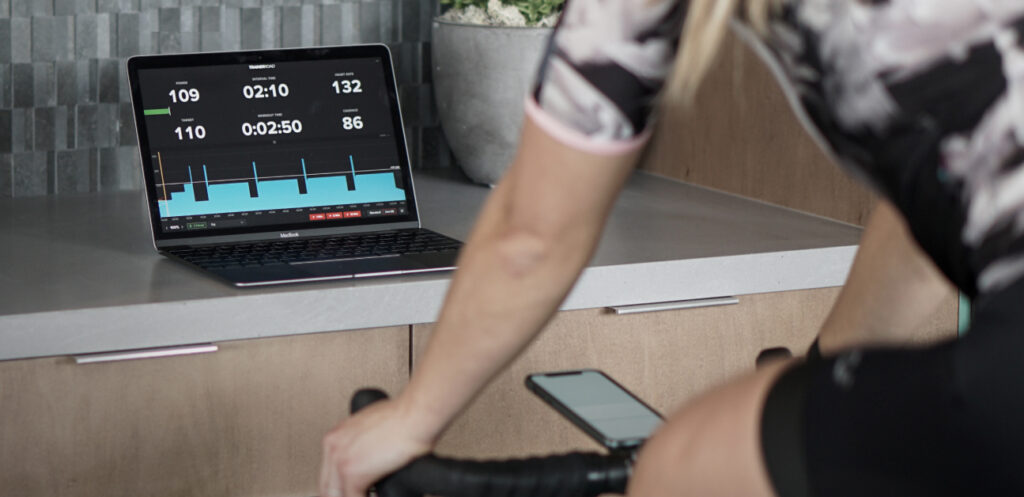Indoor Cycling Training Plan: Beginner’s Guide to Indoor Cycling
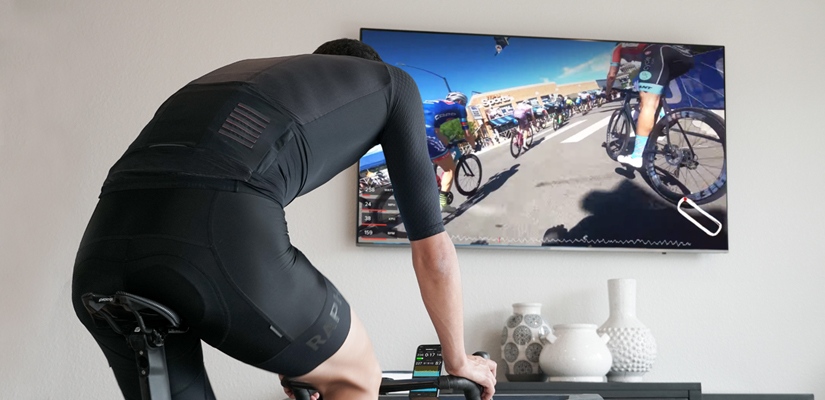
Regardless of your experience level, getting started with a beginner indoor cycling training plan is easy. With the demands of family and work life, indoor cycling training is not only convenient, but it’s also incredibly efficient—meaning you can get faster in less time. In this guide, we’ll cover indoor cycling training plans, workouts, and tips for success.
Table of Contents
For more indoor cycling training tips, check out the Ask a Cycling Coach Ep 239
Indoor Cycling Training Plan
Structured training is the most efficient and effective way to become a faster cyclist. An indoor cycling training plan is a way to organize your hard work through power-based, interval workouts. Every TrainerRoad training plan is optimized by leveraging the power of Adaptive Training and science-based coaching principles that are designed to increase your fitness.
One of the best ways to take advantage of the convenience of your trainer is to create an indoor cycling training plan that focuses on you and your goals. Plan Builder removes the guesswork by accounting for your available training time, experience, and goals. You can also select from over 100 indoor cycling training plans to match your chosen cycling discipline. So whether you are racing cross-country MTB, riding a gran fondo, or simply want to improve your fitness, there’s a plan for you.
Why a Training Plan is Important
An indoor cycling training plan serves as the foundation of structured training. Structured training is a process by which you train specific energy systems while progressively stressing your body. It begins with a plan and uses specific power-based workouts that are designed to make you faster in the most effective and time-efficient way. As a result, you gain performance-boosting adaptations, increasing your FTP, VO2 max, and muscular endurance.
Adaptive Training
Get the right workout, every time with training that adapts to you.
Check Out TrainerRoadWhat to Look for in a Training Plan
When considering indoor cycling training plans, you’ll want one that will account for your goals, events you plan to complete, the amount of time you have to train, and your training experience. The good news is that you can create a custom training plan with Plan Builder.
With Plan Builder, you get a science-based program without the complications or guesswork. Using your current training volume, when and how long you can train, the events in your training calendar, and your goal event’s demands, Plan Builder builds the ideal training plan for you.
Tips for Choosing a Training Plan
- For beginners, start with a low-volume plan.
- Pick a plan that aligns with your goals or event type.
- Start with base training to build your aerobic capacity.
Indoor Cycling Training Plan for Beginners
Beginning an indoor cycling training plan can seem daunting. But the good news is that whatever your fitness level, TrainerRoad has the right training plan for you. However, there are a few things to consider if you’re new to indoor cycling training.
One of the most important first steps is to access your fitness level with an FTP test. FTP is your Function Threshold Power and serves as a way to scale the workouts to your current fitness. Every TrainerRoad training plan begins with a Ramp Test. It’s a short, simple, and accurate way to measure your fitness.
How to Choose the Best Indoor Cycling Training Plan
The best plan for you is one that matches your available training time and experience. TrainerRoad training plans come in three volumes: low-volume, mid-volume, and high-volume. While the hourly commitment can vary, on average, the low-volume plans have three structured workouts per week, the mid-volume plans have five, and the high-volume plans have six. Whenever you start a new training plan, you’ll need to choose a volume for your plan.
When choosing a volume, we typically advise that you select the one that you can consistently complete. That means that your indoor cycling training plan volume should match your available time and provides enough rest in between workouts.
Sample Indoor Cycling Training Plan for Beginners
For beginners, we recommend starting with Low-Volume Sweet Spot Base. This will have you on the bike three times a week for a total of three to four hours. Divided into two six-week blocks, this plan will develop your aerobic base fitness and muscular endurance. Here is a sample of the first three weeks of the plan.
Week 1
This week is dedicated to assessing your current fitness, targeting your leg speed & speed endurance, and then dialing back the intensity to work on your pedaling form during the long weekend ride.

Week 1 Tip: Cyclists new to power-based training or simply new to the act of assessing their fitness should try to be well-rested prior to testing.
Week 2
Two of this week’s three workouts will subject you to increasingly longer periods of moderate-intensity muscle endurance work. This will pave the way for later improvements in your ability to sustain higher power output for longer lengths of time.

Week 2 Tip: Complete the pedal form drills in the workout instruction to increase your efficiency and cadence.
Week 3
This week kicks off with some focus on pedal economy via leg-speed drills, before shifting to your ability to keep reasonably high power to the pedals. In fact, the weekend’s long workout is entirely about spending greater total time increasing your ability to resist fatigue when riding at high percentages of your FTP.

Week 3 Tip: When it comes to leg speed, practice the “less is more” approach when it comes to fast, fluid pedaling. Let go of nearly all the tension below your knees by relaxing your feet, ankles and your calves and imagine you are pedaling with your knees. Remember that the more quickly you pedal, the less forceful each pedal stroke becomes—think speed, not force.
Indoor Cycling Workouts for Beginners
TrainerRoad has over 3,000 indoor cycling workouts ranging from recovery rides to race simulations and everything in between. Most workouts feature coaching tips and workout instructions to help improve your pedaling, efficiency, and mindset. Each indoor cycling workout targets a specific fitness adaptation and a generally organized by power zone.
If you aren’t ready to start a training plan, but still want the benefits of structured workouts, you can use TrainNow. TrainNow gives you the flexibility to complete structured training, when and how you want, with intelligently recommended workouts in three different categories—Endurance, Climbing, and Attacking. Here are some examples of indoor cycling workouts.
30 Minute Cycling Workout
This thirty-minute workout is great for getting started with structured training.
- 3 minutes – 50% of FTP (4 RPE) warmup
- 2 minutes – 88% of FTP (8 RPE)
- 2 minutes – 40% of FTP (4 RPE) recovery
- 5 minutes – 88% of FTP (8 RPE), followed by a 2-minute recovery
- 6 minutes – 92% of FTP (8 RPE), followed by a 2-minute recovery
- 7 minutes – 90% of FTP (8 RPE)
- 1 minute – 40% of FTP (RPE 3) cooldown
Short Intro Workout
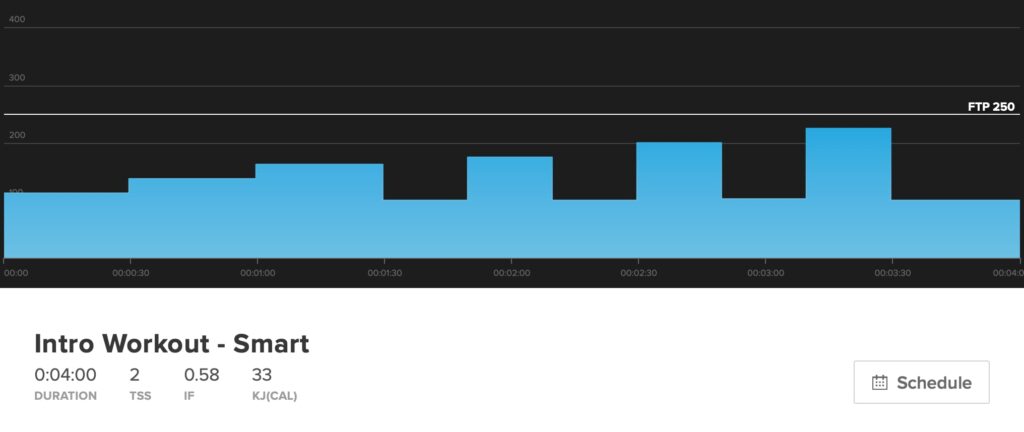
This short, four-minute workout is an introduction to riding on a smart trainer. If you’re new to erg mode and indoor training, this is a good start.
60 Minute Endurance Workout
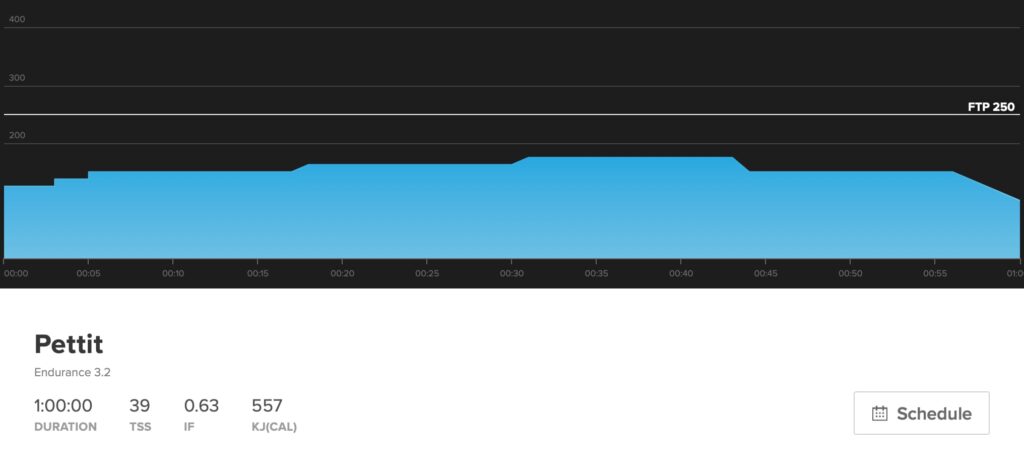
Pettit is an hour-long endurance workout. It includes cadence drills and form sprints. Workouts like Pettit improve oxygen delivery & utilization, increase muscular resistance to fatigue, and even help you improve your on-bike nutrition strategies. Endurance workouts, like this one, are important in an indoor cycling training plan because they serve as a way to increase fat utilization and aerobic fitness with minimal needed recovery.
60 Minute Sweet Spot Workout
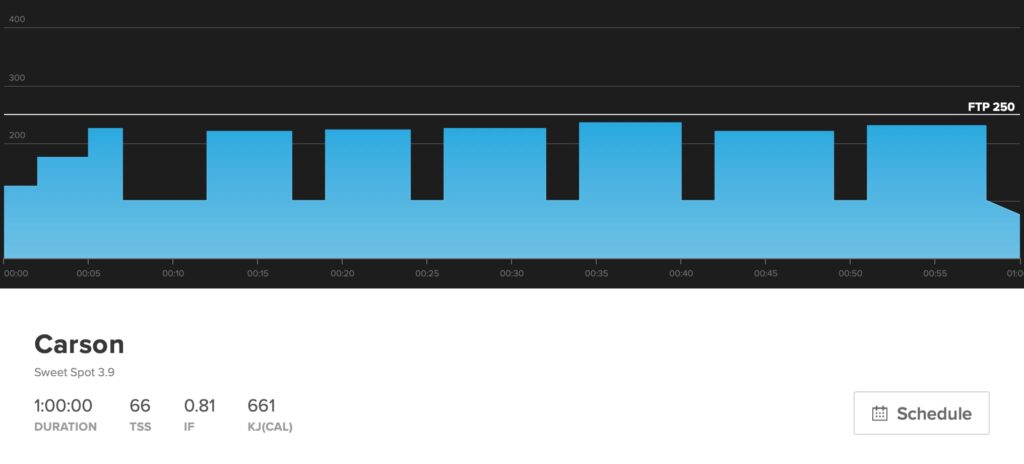
Carson is a Sweet Spot workout designed to expand your aerobic base fitness and increase muscular endurance. During the hour-long ride, you’ll complete six intervals that last between five to seven minutes while completing climbing drills. Sweet Spot workouts like this are vital for an indoor cycling training plan because they allow you to get faster in less time. Sweet Spot workouts are tough but doable, and require more recovery than an endurance workout. However, they need far less recovery time than a more intense Threshold or Sprint workout.
During the Base Phase, you’ll these types of workouts a few times a week. Aside from the significant fitness gains and increases in FTP, you’ll improve your pedaling form and mechanics. To learn more about Sweet Spot training, check out our guide: Sweet Spot Training: Everything You Need to Know.
60 Minute VO2 Max Workout
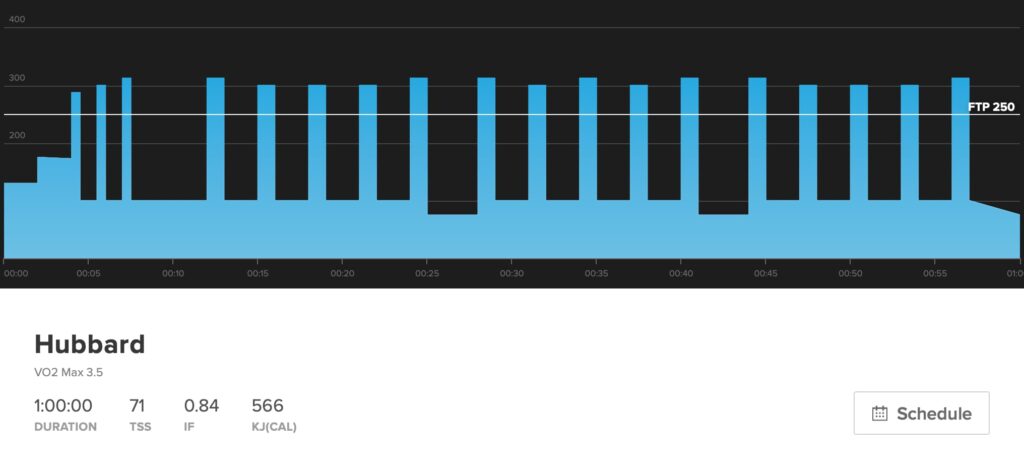
Hubbard is a VO2 Max workout that improves your maximum aerobic power and the ability to repeatedly operate near it. Workouts like these are included in indoor cycling training plans because they drive aerobic adaptations that increase your FTP. However, these workouts are tough and require a good amount of recovery. As a result, they should only be done a few times a week at most.
Workout Tips for Indoor Cycling Beginners
- Adjust your setup. Everyone has different preferences for their indoor training space. Experiment and discover what works best for you.
- Trust the Process and follow your plan because consistency leads to long-term fitness growth.
- Set up things in advance for ultra-convenient workouts. Prepare your bottles and kit the night before, so all you have to do is get dressed and hop on the trainer.
- Commit to starting. Sometimes motivation runs low. If that’s the case, commit to starting the workout. Usually, you’ll feel much better after the first interval.
- Emphasize recovery. Training places tremendous stress on your body, so make sure you are getting enough rest, sleep, and nutrition.
Benefits of Indoor Cycling
Training indoors offers tons of benefits in comparison to riding outside. It’s convenient, easily accessible, and isn’t affected by the weather. Perhaps the biggest advantage to indoor training is the sheer efficiency. Training indoors means that you can precisely hit your power targets without wasting time waiting on traffic.
For many beginners, one of the most significant differences with indoor cycling workouts is constant pedaling. Typically, riding outdoors offers numerous small breaks from pedaling, but the pedals are always turning on the trainer. This can be a challenge for many beginners. Don’t worry! Soon, constant pedaling will be a strength that transfers to performance outside.
Indoor Trainer Setup
Before you get started with indoor training, you need some equipment first. But don’t worry, getting started with TrainerRoad is easy. There’s some equipment that you will need and some items that will help maximize your hard work.
At the very least, you need a bike, trainer, sensor, and a device to run the TrainerRoad app. The choices for trainer and sensor will depend on your budget, but the good news is that there are plenty of options.
Accessories for Indoor Cycling Training
Besides a trainer, you’ll want to budget for some accessories that can improve your indoor training experience.
- A good fan to keep cool.
- A few gym towels to keep sweat off your bike.
- Sweatproof headphones to listen to your favorite songs.
- Water bottles so you can fuel your training
- A stand or holder for your device.
Adaptive Training
Get the right workout, every time with training that adapts to you.
Check Out TrainerRoadEntry-Level Trainers
The lowest cost option is to use VirtualPower with a trainer and a speed sensor. That way, you can get the benefits of power-based training without the cost of a power meter or a smart trainer. VirtualPower supports nearly every trainer on the market. Check out our equipment checker to see if it’s supported.
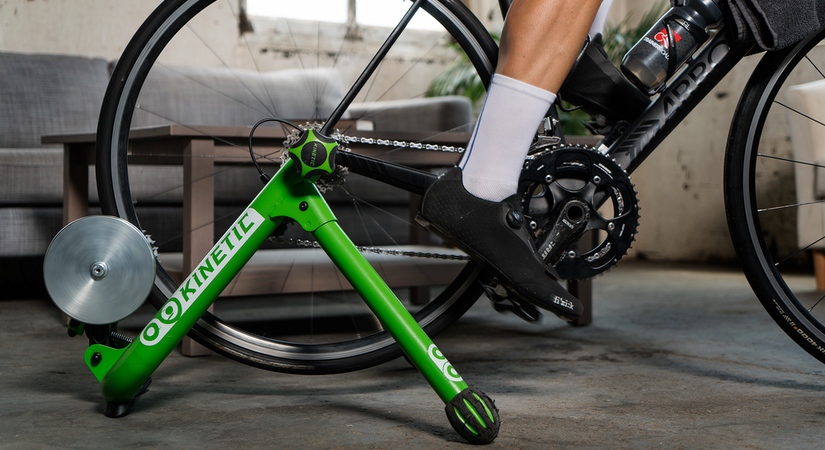
Here are our recommendations for the best entry-level trainer for beginners to indoor training.
Kurt Kinetic Road Machine Smart 2
Feedback Sports Omnium Over-Drive (Great if space is an issue)
Garmin Speed Sensor 2
Mid-Level Power Meters
The best indoor trainer for a mid-level budget is one of the trainers listed above and a power meter. This is a lower-priced option if you already have a trainer.
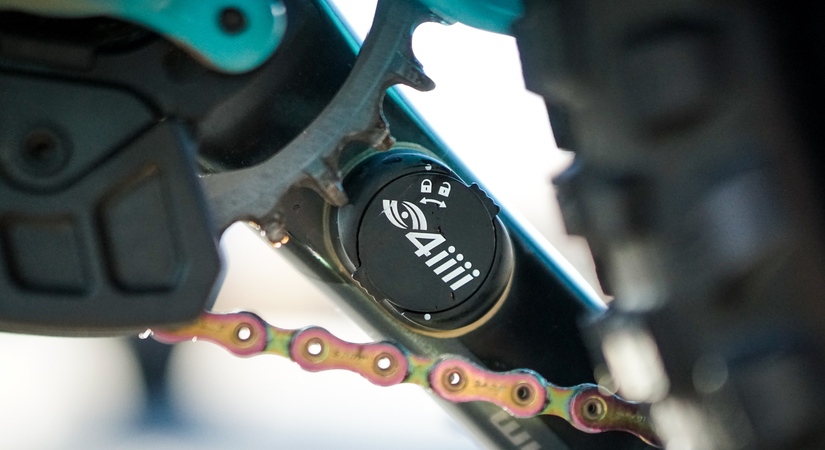
Buying both a trainer and power meter will cost more, but the versatility allows you to take your training outdoors with Outside Workouts. Here are our recommendations for mid-level power meters.
Stages Gen 3 Power Meter
4iiii Precision Power Meter
High-End Indoor Trainers
For the best indoor trainer experience, a smart trainer is the way to go. These trainers automatically control the resistance, which can be especially helpful for beginners. Here are the smart trainers we recommend.
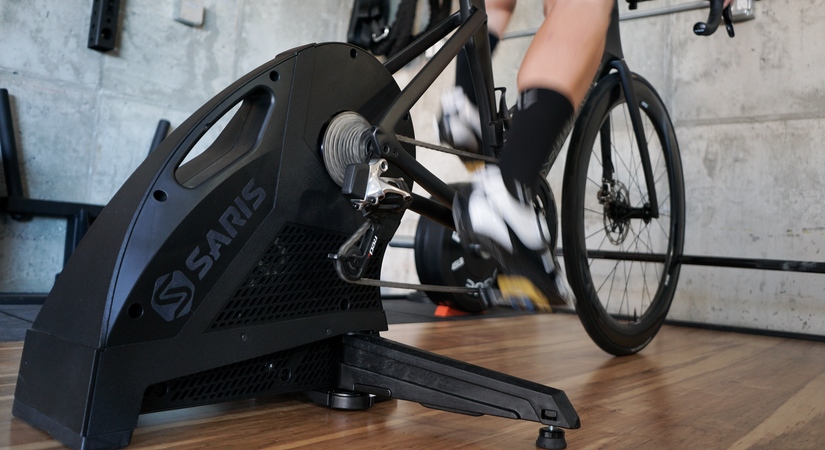
Saris H3
Tacx Neo 2T
Wahoo Kickr
Once you have your equipment set and an indoor cycling training plan, it’s time to get to work. Indoor cycling workouts are a different experience from outdoor riding. Below you’ll find some tips that will help you nail every workout and stay consistent throughout your training.
Before The Workout
Build the Right Training Plan
Start with low-volume training and work your way up over time. As a beginner to indoor training, you’ll want to complete a Ramp Test first.
Sleep 8-10 Hours A Night
One of the most overlooked aspects of your recovery is sleep. More sleep will improve your overall quality of life, allow you to train more, and recover faster.
Fuel Your Workout
Your body needs the proper fuel for intense workouts. Eat a healthy carb-centric meal 3-4 hours before to give your body the fuel it needs. Try to focus on nutrient-dense, whole foods.
Take Some Caffeine
Caffeine reduces your perceived exertion, making the workout seem a little easier. It takes about an hour after ingestion to reach its peak effectiveness, but don’t intake it too late in the day and disturb a good night of sleep.
Train With Your Friends
You can use the Group Workouts feature and get faster together. Share voice, video, and data to get that extra motivation.
During The Workout
Keep Cool
This is the most common beginner mistake of indoor training equipment that we see. Get at least one fan that moves a high volume of air and position it to cover the maximum amount of surface area on your body as possible.
Listen to Music
A good song can motivate you to push through a hard workout. If you are going to use headphones, we recommend ones that have an IPX4 rating or higher to keep out the sweat.
Watch Something
Watch and learn from the great race analysis videos on our YouTube channel. Try incorporating more involved entertainment options like your favorite movie or TV show during the easier aerobic workouts.
Drink Up
Aim for at least one bottle every hour and maybe more. Pro tip: add some ice to the bottle to help reduce your core temperature.
Fuel Again
Another beginner misconception is that you don’t need to fuel like you would on a normal ride since the workout is short or indoors. If anything, indoor training is particularly hard, so fueling your workouts is crucial to good performance. This can be as simple as eating a gel or drinking a sports mix. Not only are you training your GI system to handle carbohydrates, but you are developing good nutrition habits for race day.
After The Workout
Set Up For The Next Workout
Even the smallest obstacles to getting started with your workout can be enough to keep you from training. Prepare your water bottles, set out your shoes and kit, keep a bike on the trainer, and keep your fan in place. Use a remote outlet for your fan if you can, and make sure to have a device ready to run TrainerRoad in your training area. Doing this saves time and will make it easier to get on the bike.
Analyze Your Workout
Take a look at your workout data with the Ride Analysis features on TrainerRoad to see PRs, find failure points, and get an idea of how hard the workout really was. Use the Ride Notes feature to write down what worked and what didn’t. Analyzing the data will help you see the impact of your training and keep you on track for your goals.
Enjoy Your Hard Work
You did it, now enjoy it. Endurance athletes can be notoriously hard on themselves. Take a few moments to celebrate smaller training victories to counterbalance the disappointing days we all have. This will help stoke your motivation as your training continues.
For more cycling training knowledge, listen to Ask a Cycling Coach — the only podcast dedicated to making you a faster cyclist. New episodes are released weekly.
